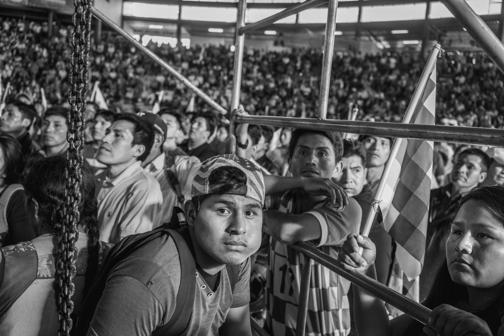
(above) Morales’s charismatic populism has continued to galvanize supporters even while the former President is in exile. At a recent rally organized by his political party, the Movement Toward Socialism, the crowd cheered, “Evo, you are not alone!” Photograph by Moises Saman / Magnum for The New Yorker
Letter from Bolivia
The Fall of Evo Morales
March 16, 2020 - Original article: The New Yorker
A controversial socialist leader fled his country. Was he deposed—or did he escape justice?
By Jon Lee Anderson
Outside a sports stadium in Cochabamba, Bolivia, three men stood on a plinth, tearing down a statue of Evo Morales, who until a few weeks before had been the country’s President. One man diligently whacked away with a sledgehammer, while another shoved at the statue’s head—crowned, like the man it portrays, with a mushroom-shaped mullet that is distinctive among world leaders. Finally, the statue came loose, and with a contemptuous heave the men threw it to the ground. The sports minister of the new government, who had helped with the demolition, told reporters afterward that stadiums shouldn’t be named for delinquents.
Morales had fled Bolivia in November, after he was accused of trying to steal an election, and the country’s military chief publicly suggested that he resign. Since then, Bolivia had been fiercely, sometimes violently divided. Many people spoke of a coup, but there was enduring disagreement over whether it had been perpetrated by Morales or by his opponents. Whoever was to blame, his departure brought an abrupt end to one of Latin America’s most remarkable Presidencies. The son of impoverished llama herders, Morales was an ethnic Aymara, the first indigenous President in a majority-indigenous country. Although he left school before college and speaks in rough, heavily accented Spanish, he managed to hold power for almost fourteen years. He was a protégé of Fidel Castro, and perhaps the last surviving exponent of the Pink Tide—the leftist leaders who dominated Latin America’s politics for more than a decade. During his time in office, he transformed Bolivia, reducing poverty by almost half and tripling the G.D.P.
Evo, as everyone calls him, is a sturdy, youthful-looking man of sixty, who prides himself on outlasting opponents in soccer matches in Bolivia’s Andean high altitudes. (During one game, in 2010, he was captured on video deliberately kneeing a distracted opponent in the groin.) As recently as last year, he claimed to stay fit by doing more than a thousand sit-ups a day. In the Presidency, he was tireless, beginning his workday at 4:45 A.M. and continuing late into the evening. A charismatic populist, he could also be arrogant and divisive, given to crass and at times eccentric proclamations. On one occasion, he suggested that eating genetically modified chicken made people gay. On another, he had the Congress building equipped with a “Clock of the South,” with hands that spun to the left, to symbolize Bolivia’s efforts to “decolonize” itself. A longtime leader of the coca growers’ union, Morales used his office to expound the medicinal properties of the plant; behind the Presidential desk, he hung a portrait of Che Guevara, made out of coca leaves.
After Morales’s contested election, several of his highest-ranking officials resigned along with him, including the three people after him in the line of Presidential succession. The office was claimed by a member of the conservative opposition: Jeanine Áñez, a fifty-two-year-old former television presenter, who was then serving in the largely ceremonial post of second vice-president of the Senate. Within two days, Áñez had been endorsed by the military and proclaimed herself President, donning the sash of office as generals looked on approvingly. She alienated the indigenous population just as quickly, leading a scrum of followers to the Presidential palace, where she raised an outsized Bible and declared that she was “returning the Bible to the palace.” Áñez, a light-skinned blond woman, made things worse by naming an all-white cabinet. Following an outcry, she added an indigenous minister, but by then Morales’s loyalists had branded her “la mujer teñida” (“the dyed woman”) or, simply, “the whore.”
In office, Áñez signed a decree prohibiting “personality cults” in Bolivia’s institutions, and made it clear that she intended to purge Morales’s legacy and his presence from public life. A Presidential employee told me that Áñez had toured Morales’s former offices, accompanied by a man dressed in native robes and another carrying a Bible. While she prayed before portraits of Bolivia’s national heroes, the robed man blew a horn, as if to chase off evil spirits. The employee told me that when Áñez encountered the coca-leaf portrait of Che she grew visibly upset and ordered it removed.
Áñez and her allies argued that Morales had turned the country into a socialist autocracy, and that only by removing him could it heal. Morales, from exile in Mexico, insisted that he had created modern Bolivia—that the nation effectively didn’t exist without him. When I spoke to him this winter, in one of a series of conversations, Morales described Bolivia’s tradition of political instability. In a hundred and ninety-five years as an independent republic, it has seen no fewer than a hundred and ninety revolutions and coups; Morales’s ouster was arguably the latest one. “They said my government was authoritarian because I was President for a long time,” he told me. “They called me ‘Dictator Evo Morales,’ but now the Bolivian people can see what it’s like to live in a dictatorship, what it is to live with a coup d’état.” Morales argued that he should be allowed to come back and finish his term. Failing that, he assured me, his bloc—the Movement Toward Socialism, or MAS—would resume control of Bolivia one way or another. “I will return, and we will be millions,” he said. He was paraphrasing the last words of one of his heroes, the eighteenth-century anti-colonial rebel Túpac Katari, just before he was pulled to pieces by four Spanish horses.
One afternoon, as I waited outside the Presidential palace to meet Áñez, a young man walked up and ostentatiously spat on the ground next to me. He seemed, perhaps understandably, to have mistaken me for an American official, there to assist the new regime.
| (below) Morales likes to say that he did not just lead Bolivia—he “refounded” it. Photograph by Moises Saman / Magnum for The New Yorker. | (below) Jeanine Áñez, the interim President, says that she brought “liberation.” Photograph by Moises Saman / Magnum for The New Yorker | |
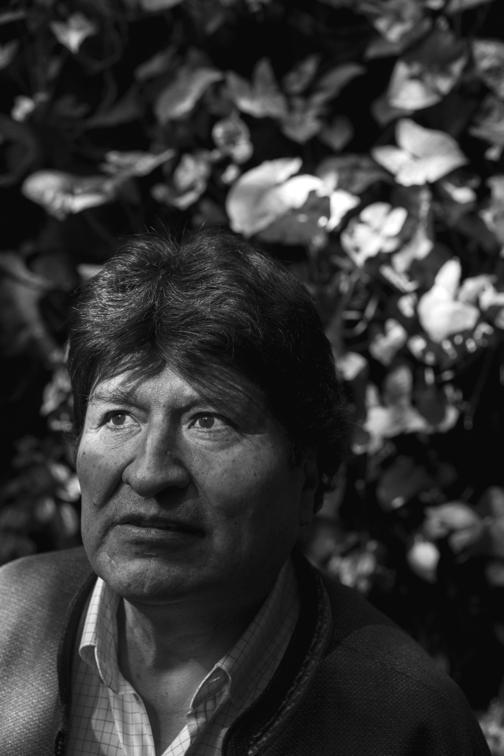 |
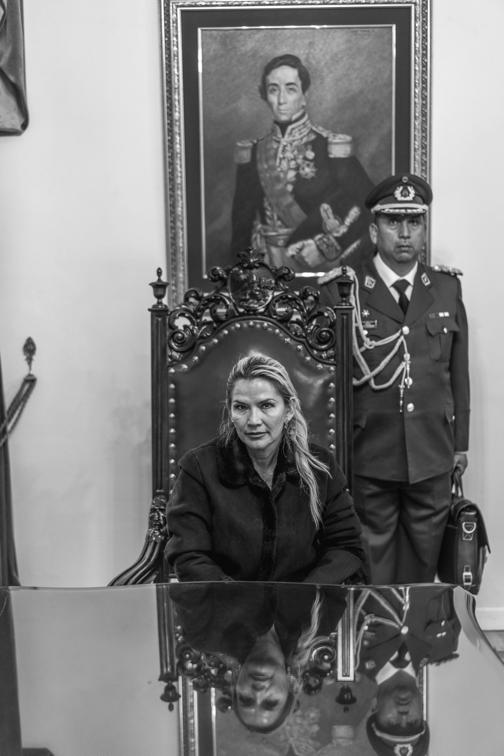 |
It was early December, three weeks after the collapse of Morales’s government, and Bolivia remained polarized. In the wealthier neighborhoods of La Paz, the graffiti called Morales an assassin, a dictator, a narco; in the poorer, more indigenous districts, slogans proclaimed “Evo Sí” and “Áñez Fascista.” Two blocks from the palace was a spray-painted message, “Alert: They are killing us,” which could have come from either camp.
The Palacio Quemado, or Burnt Palace, as it is known, earned its name in 1875, when an angry mob torched it in an attempted coup. Its replacement, a pink-and-white neocolonial structure, has survived intact, but in 1946 the reformist President Gualberto Villarroel was murdered there in another mob attack, his body hurled from a balcony and then hanged from a street lamp in the plaza below. The street lamp still stands, flanked by a plaque commemorating Villarroel’s death. The plaza, a quiet place with shade trees and balloon venders, is named for Pedro Domingo Murillo, a Creole patriot who sparked Bolivia’s war of independence against Spain, in 1809. Soon afterward, he was captured by royalist troops and hanged.
As if to repudiate this ugly history, Morales built a skyscraper, called the Great House of the People, to serve as a headquarters for his “democratic and cultural revolution.” A gleaming rectangle of glass and steel, the Great House rises twenty-nine stories above the old palace, and contains the Presidential offices and living quarters, along with several government ministries. Morales’s political opponents criticized the construction, which cost some thirty-four million dollars, as an extravagant vanity project. After he fled, the new communications minister led a press tour of his chambers, which she derided as “worthy of an Arab sheikh.” News photographs showed a spacious but rather sterile bedroom and a marble-lined bathroom with a Jacuzzi—a nice place, but not much more luxurious than a Sheraton Four Points.
Áñez had rejected the Great House and installed herself in the Palacio Quemado. I waited for her there in a receiving room, watched over by a gilt-framed portrait of Simon Bolívar, the country’s namesake. As Áñez and her entourage arrived, a soldier and a plainclothes bodyguard took up protective positions: one behind her, the other by a window overlooking the plaza. A man in a business suit introduced himself as Erick Foronda, Áñez’s private secretary. When I said that he looked familiar, he deadpanned, “That must be because I am a C.I.A. agent.” Foronda had been an adviser at the U.S. Embassy in La Paz for more than two decades. Morales, who often accused the U.S. of covertly meddling in Bolivia, expelled the American Ambassador and the Drug Enforcement Administration in 2008, and the U.S. Agency for International Development in 2013. That year, Morales claimed that, while he was returning from an official visit to Russia, the U.S. government ordered his Presidential jet diverted to Vienna, on the suspicion that he was sneaking Edward Snowden into Bolivia with him. (He wasn’t.)
During the first two years of the Trump Administration, Foronda lived in Washington. Now Morales’s allies were portraying his presence in the palace as indisputable evidence that the U.S. had supported a coup. In January, Radio Habana Cuba ran a story titled “Áñez’s Private Secretary Insures the Subordination of Bolivia to Washington.” Although the story was full of implausible assertions—it suggested that the U.S. had forced out Morales in order to secure Bolivia’s supply of lithium—Áñez’s government was unabashedly right-wing. She had swiftly expelled Venezuelan diplomats and Cuban doctors, accusing them of financing pro-Morales mobs. The first ruler to congratulate her on her Presidency was Brazil’s far-right leader, Jair Bolsonaro; the second was Donald Trump. (In the U.S., left-leaning sympathizers such as Bernie Sanders and Alexandria Ocasio-Cortez decried what they saw as a coup.)
The palace was chilly during our meeting, and Áñez wore a black coat over a black dress. She spoke in a soft but firm voice, explaining that she had a sore throat from talking too much. What happened in Bolivia, she said, had been a “liberation” from Morales’s politics of class division and hatred. “This was fourteen years of dictatorship, fourteen years of lies, fourteen years of oppression, from which we are trying to free Bolivians, to bring about a transition that can become a new starting point, a place where no one prohibits us from thinking differently,” she said.
I asked Áñez if her appearance with the Bible at the Palacio Quemado might have alarmed Morales’s loyalists by signalling her allegiance to the far right. “I am a woman who is close to the Bible, and I am close to God,” she said fervently. “If that means I am an ultra-rightist, then I must be one.” She asserted that more than eighty per cent of Bolivians were also “people of faith,” and accused Morales of “not believing in God,” and of having “other beliefs,” a comment that echoed an old tweet, since deleted, in which she denigrated Aymara religious beliefs as “satanic.”
Áñez assured me that she had never expected to become President: “It was something God put in my path.” But, she added, since she had taken the job Bolivia had become more stable, and the necessary political transition was taking effect. Although “many Bolivians” had told her they appreciated her efforts, she had no plans to run in the next elections, which were planned for May. She saw herself as “an instrument” in the task of “pacifying and stabilizing” the country.
Despite Áñez’s talk of peace, there was a palpable sense that an ideological purge was under way. Her interior minister, Arturo Murillo, had vowed to “hunt down” his predecessor, Juan Ramón Quintana, who had taken refuge in the Mexican Embassy. (Murillo was known for harsh talk; as a senator, he had once said that women had no right to receive an abortion, though they should feel free to “kill themselves by throwing themselves out of a fifth-floor window.”) If there was any suspicion that his hunting metaphor was a figure of speech, he dispelled it by describing Quintana as “an animal” that “feeds on the blood of the people.” Murillo also promised to pursue Morales for being a “narcoterrorist.” Áñez made the same charge, and told me that Morales would have to face justice if he ever returned to Bolivia.
When I first spoke to Morales, in a telephone call two days after his arrival in Mexico, he insisted that he was the victim of a conspiracy, in which oligarchs in Bolivia were abetted by imperialists in the U.S. “They don’t forgive me, because I nationalized the natural resources,” he said. “They don’t forgive me, because I reduced extreme poverty. In the capitalist system, the idea is that if you’re poor you should look after yourself, and there won’t be any social problems. But that doesn’t work in Bolivia.” As he had done many times before, Morales accused his enemies of racism, saying that they couldn’t bear the fact that an “indio” had been President.
(below) La Paz boomed under Morales, but the goals of economic growth and social uplift sometimes fitted together uneasily.Photograph by Moises Saman / Magnum for The New Yorker
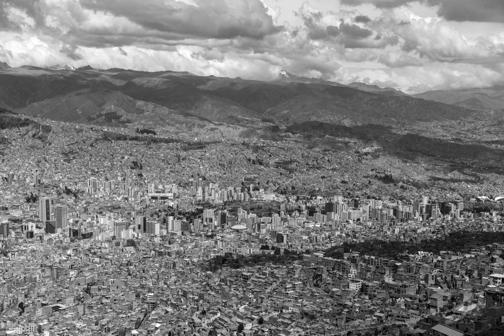
Morales likes to say that he did not just lead the country—he “refounded” it. Since the days of the Spanish occupation, Bolivia had been effectively two countries: one indigenous and mostly rural, the other white and mostly urban. During Morales’s first term, he pushed through a new constitution that changed the country’s name from the Republic of Bolivia to the Plurinational State of Bolivia, to reflect its “communal and social” diversity. He adopted the indigenous symbol the wiphala—a checkerboard of bright colors, meant to represent Bolivia’s many peoples—as a national emblem, equal to the flag. At state functions, he wore a collarless alpaca-wool suit, accented with vivid Aymara embroidery.
The revamped constitution also changed Morales’s electoral fortunes. Bolivia’s Presidents had been forbidden to serve consecutive terms, but a new provision allowed two in a row. In 2013, as Morales approached the two-term limit, he convinced the courts that his first term, which came before the constitution was amended, shouldn’t count toward his total; the following year, he won office again. In 2016, he tried yet another gambit: he held a referendum asking Bolivians to override the constitution and allow him a fourth term. The voters narrowly rejected his request, but the country’s constitutional court obligingly ruled that to prohibit Morales from running would violate his human rights. In 2018, an even more pliant body, the supreme electoral court, ratified the verdict.
Many Bolivians were incensed, and the opposition held protests. But Morales retained widespread support, especially among poor and indigenous citizens. Last October 20th, he stood for reëlection, and felt confident about his chances. His opponent was Carlos Mesa, a former journalist who had twice had his career disrupted by Morales. Mesa had served as Vice-President from 2002 until 2003, when the sitting President fled the country, amid violent protests that stemmed from his privatization of natural-gas reserves—a conflict known as the Bolivian Gas War. Mesa became President, only to resign as well as the dispute continued. Both times, Morales was a prominent leader of the opposition.
On Election Day, early results showed Morales ahead by about seven points, but he needed a ten-point lead to avoid a second round of voting. That evening, with eighty-four per cent of the vote counted, the electronic tally was suddenly halted; when it resumed, twenty-four hours later, Morales had secured a margin of just over ten per cent. Mesa and his supporters erupted into accusations of fraud, and they soon convened nationwide strikes to demand new elections.
Both Morales and his opponents refused to give way, snarling the country in protests and counter-protests. Finally, Morales agreed to allow the Organization of American States to investigate the election, and on November 10th the O.A.S. published its findings. The auditors said bluntly that “serious irregularities” had occurred, mostly in Morales’s favor, and recommended that a new election be held. Morales quickly acknowledged the report and announced his support for a new vote. But, before that could happen, Bolivia’s armed-forces chief, Williams Kaliman, appeared before television cameras to “suggest” that Morales resign, “for the good of Bolivia.” The commander of the national police echoed his call.
Morales understood that his Presidency had come to an end. Police units around the country had mutinied, and Presidential guards had abandoned their posts. In the hangar that contained the Presidential jet, Morales held a press conference, and tendered his resignation in a frowning, hurried statement. Then he and a few close aides flew to his rural stronghold, in the coca-growing region of Chapare. After he sent word to his followers to assemble at the airport there, thousands showed up to protect him from possible arrest. The next day, Morales tweeted a photograph of himself in a safe house. It showed him lying on a blanket on a concrete floor.
(below) In Bolivia’s wealthier neighborhoods, the graffiti called Morales an assassin, a dictator, a narco; in the poorer, more indigenous districts, slogans proclaim “Evo Sí” and “Áñez Fascista.”Photograph by Moises Saman / Magnum for The New Yorker

For twenty-four hours, Morales remained out of sight, while Andrés Manuel López Obrador, the left-of-center Mexican President, dispatched a jet to fly him to safety. Mexico’s foreign minister, Marcelo Ebrard, had made it clear that his government regarded Morales as the legitimate President of Bolivia, who had been toppled in a military coup. When Morales landed in Mexico, Ebrard greeted him in a warm embrace. Later, he told me that Morales had expressed fear that if he didn’t flee the country he would be killed.
In the chaos around Morales’s resignation, the leaders of MAS made a grievous political error when the three highest-ranking officials also resigned. Their gesture was interpreted as a protest, but, by resigning, they vacated the line of succession for the Presidency. As a result, Áñez, whose party had won just four per cent of the vote in the previous election, was able to declare herself president of the Senate—and thus next in line to lead Bolivia.
Áñez took charge of a country in tumult. Morales’s opponents had raucously celebrated his departure, waving Bolivia’s tricolored flag in the street. On Twitter, Carlos Mesa hailed “the end of the tyranny.” Others had attacked Morales’s lieutenants and vandalized their homes. A mob looted a house that Morales owned in Cochabamba, and set fire to one owned by his sister. In Potosí, the brother of MAS’s congressional leader was stripped naked and paraded around the main square, while his house was torched. Another opposition mob grabbed the mayor of a town near Cochabamba, cut off her hair, doused her in red paint, and marched her through the streets while beating her.
Morales’s supporters had clashed with police; others burned and looted businesses and the homes of some of his prominent critics. Mobs set fire to sixty-eight buses in La Paz, and snipers fired on a caravan of pro-opposition miners, wounding several. Others blockaded the roads leading to Bolivian cities, cutting off supplies of food and fuel.
On November 12th, the day that Áñez took office, she deployed the police and the Army, and soon offered immunity for any crimes they might commit in their efforts to reassert social control. Within days, the security forces were involved in two massacres of Morales supporters. On the fifteenth, a group of militant cocaleros, marching in support of Morales, approached police lines on a bridge in the town of Sacaba, and nine were killed by gunfire. Three days later, in the Aymara city of El Alto, Morales supporters blockaded a state-owned gas-storage facility called Senkata. Security forces opened fire, killing at least ten.
Áñez’s government maintained that the security forces had averted a “terrorist attack” at Senkata. Officials claimed that the demonstrators had intended to blow up gas holding tanks, causing as many as fifty thousand deaths. But investigators for the O.A.S. rejected this explanation. A MAS organizer who was there that day told me that the demonstrators had wanted to “gain attention,” so they dug trenches in the dirt road outside the facility, to halt fuel trucks. But the government had dispatched bulldozers to fill the ditches, so they had thrown rocks at the bulldozers, and then soldiers had begun shooting. “That woman has lied,” the organizer said, of Áñez. “She said we were carrying firearms, but that’s an infuriating lie.”
By the time Bolivia’s unrest subsided, at the end of November, thirty-four people were dead and hundreds had been injured. Arturo Murillo, the new interior minister, told me that Áñez’s administration bore no responsibility. “Out of all of the dead in the country—and each of them pains us—there is not any sign that one of them was caused by the government,” he said. “The majority are dead from a .22-calibre bullet in the back of the head, or else in the back, or under the arm. What does this mean? This means that the people of MAS, those who stirred up the unrest, killed these people to get things going.”
Murillo has provided no evidence for his claims. It is true that Morales’s followers committed violence. (Morales himself argued that they had been provoked by policemen ripping wiphala badges from their uniforms and burning them. “Naturally, a great uprising is under way to restore the honor of our patriotic symbols,” he said.) But they accounted for only a handful of deaths—roughly equal to the number of Morales supporters killed by opposition mobs. The security forces killed at least nineteen people, and reports suggest that the total could be considerably larger.
(below) Portraits of Che Guevara, Nelson Mandela, and other revolutionary leaders hang in Morales’s former Presidential offices.Photograph by Moises Saman / Magnum for The New Yorker
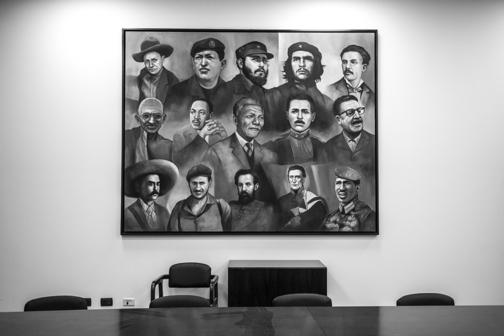
Amid the violence, nine senior officials took refuge in the Mexican Embassy in La Paz, while others with links to Morales fled the country. When I asked Murillo about reports of persecution of MAS members, he grew testy. “We aren’t going after just anybody—just the terrorists, seditious people, those who want to hurt our country,” he said, his voice rising to a menacing shout. “We are going to persecute them, with a very hard hand.” He went on, “What is persecuting them most is their own conscience, no? They know they’ve killed, they know they’ve burned. They know they’ve stolen and they know they’ve cheated the people. There are many that have to pay a debt to the fatherland. And debts are paid, sooner or later.”
In Murillo’s view, the person who owed the greatest debt to Bolivia was Evo Morales. He said that his intelligence services had uncovered evidence that Morales had turned the country into a “narcoterrorist state.” He spoke of Venezuelan agents sent in as terrorist provocateurs, part of a vast hemispheric conspiracy run out of Cuba. Drug arrests had increased since Morales left, he said, showing that his administration had “only detained those who weren’t friends with the government.” Murillo said, “We’re going to do everything we can so that he pays for his crimes in prison.”
In December, Áñez’s attorney general accused Morales of sedition and terrorism, and asked Interpol to issue a warrant for his arrest. As evidence, the government released a recording of a phone call, allegedly made during the crisis, in which Morales could be heard ordering a union leader to tighten the MAS blockade. “No food should be getting into the cities,” he said. “Let’s block them, really cut them off.”
When I met Morales in Mexico City, later that month, he waved away the news of the Interpol warrant. “They have done everything to me that’s possible to do,” he said, laughing dismissively. When he was a cocalero leader and a congressman, the government had tortured him and imprisoned him for his activism. “What more can they do—throw me in jail?” he said. “I’ve been there already.”
(below) Waldo Albarracín, a Morales supporter turned critic, stands inside his house, which was torched by MAS loyalists in the unrest that followed the elections.Photograph by Moises Saman / Magnum for The New Yorker
 Morales was being housed on a Mexican military base with restricted access, so we met instead at a villa that doubled as the headquarters of the Venezuelan state television station. We sat under a tree in a small walled garden. Morales, dressed in a wool jacket and chinos, spoke volubly but wore a watchful expression. He seemed unable to conceive of a life away from Bolivia, especially one in which he no longer had a role in steering its destiny.
Morales was being housed on a Mexican military base with restricted access, so we met instead at a villa that doubled as the headquarters of the Venezuelan state television station. We sat under a tree in a small walled garden. Morales, dressed in a wool jacket and chinos, spoke volubly but wore a watchful expression. He seemed unable to conceive of a life away from Bolivia, especially one in which he no longer had a role in steering its destiny.
When Morales became President, many people in the business community feared that he would install an uncompromising revolutionary regime. In his office, a painting of the Aymara guerrilla Túpac Katari hung on the wall, along with portraits of Fidel Castro and Nelson Mandela. Instead, his administration had focussed on development. Morales explained to me that, early in his political life, “I once had a long meeting with Comandante Fidel Castro.” From midnight until five or six in the morning, Castro lectured him about social policies, as Morales grew increasingly bored. “Finally, I dared to ask him, ‘Fidel, where do you buy weapons from for the revolution?’ And he said, ‘Evo, no, no, no!’ ” Instead of armed insurrection, Castro wanted him to concentrate on education and health. “It made me think,” Morales said.
Morales pointed out that, in 1978, the year he performed his compulsory military service, there were three different Presidents, and the following year there were four. “Without political stability, it was impossible to think of developing Bolivia,” he said. Under his administration, he boasted, “we became the first country in economic growth in all of South America. Before, Bolivia had only ever been first in poverty and corruption.” He nationalized the country’s natural resources, and tried to bring them to market. “When I came to government, Bolivia didn’t export L.P. gas,” a form of liquid petroleum. “It imported it.” Now Bolivia exported gas to Paraguay, Peru, Brazil, and Argentina. “Before, Bolivia imported fertilizer, but now we export three hundred and fifty thousand tons a year to Brazil,” he went on. “For a small country of ten million people, that’s something—it’s an income.”
Like other leftist leaders in the region, Morales had benefitted from a decade-long boom in natural resources. Unlike some others, notably in Venezuela, he hadn’t destroyed his country’s economy by going to war with the private sector. His opposition—a mostly white, conservative establishment centered in the city of Santa Cruz—made several early attempts to oust him, ranging from nationwide strikes to a conspiracy to hire mercenaries to assassinate him. But Morales proved willing to work with capitalists, as long as they didn’t oppose him politically.
In La Paz, the effect of Evo’s pragmatism was visible everywhere. The Bolivian capital sits in a yawning crater in the Andean altiplano, more than twelve thousand feet above sea level. During the past two decades, the city has boomed. In the slums that cover the sides of the crater, the old adobe houses have been replaced by red brick, and colorful cable cars whiz overhead, ferrying passengers up and down the mountainsides. In the much expanded southern suburbs, where most of the more affluent, and whiter, paceños live, prosperous-looking teens shuttle between a United Colors of Benetton and a Burger King. In Calacoto, a neighborhood with walled villas and luxury hotels, a travel agency advertised trips to Disney World.
(below) The house where Morales was born.Photograph by Moises Saman / Magnum for The New Yorker
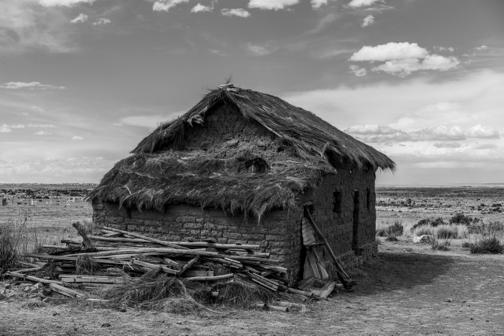
To ease inequality, Morales poured money into a universal basic pension, and started cash-transfer systems that encouraged pregnant women to seek health care and families to keep children in school. His government distributed packages of food (with his picture on them) and built hospitals and schools (with his name on them). His efforts were often theatrical—he liked to visit impoverished towns and hand out money to children—but they were effective.
Still, the goals of economic growth and social uplift fitted together uneasily. In La Paz, I met with Waldo Albarracín, the former rector of the country’s leading public university and a longtime human-rights advocate. Albarracín was an early supporter of Morales. “I voted for Evo,” he said. “Most of us who considered ourselves leftists did.” But he had come to see his Presidency as a missed opportunity. “The commodities boom generated an income of more than forty billion dollars,” he said. “The country had never seen revenues like that before.” International lenders, including the World Bank and the I.M.F., agreed to eliminate more than half of Bolivia’s foreign debt. “That would have been a good time to open up the economy further,” Albarracín said. Instead, Morales had deepened his commitment to mining, gas, and agribusiness. The left grew frustrated by his emphasis on business and his lack of interest in environmental prerogatives. Then the commodities boom sputtered. “Not only was there a slowdown of economic growth but there were corruption issues, much like those of any government of the right,” Albarracín said. “Meanwhile, Evo carried on talking like an anti-imperialist.” Albarracín, like others, became a harsh critic, and eventually his old comrades turned on him. During the unrest in November, hundreds of MAS activists converged on his house, on a quiet side street of La Paz, and set it on fire.
In Mexico City, when I pushed Morales to take some responsibility for the debacle in November, he said, airily, “We are human beings, and we all make mistakes. But can it really be said that it’s a mistake to go to an election? In my second term, after we had refounded Bolivia, my brothers of the countryside as well as my brothers of the city came and said to me, ‘Your life no longer depends on yourself—it depends on the people.’ They told me I had to stand again, to continue with the process of change.”
As we spoke, I became aware that a young woman was listening to us from a chair a dozen feet away. She had straight dark hair in pigtails, and she was dressed in jeans and a black T-shirt, with the word “LOVE” in sparkly white letters. She and Morales occasionally exchanged glances and smiled. At one point, Morales interrupted our conversation to tell my photographer not to take pictures of the woman. Later, as Morales posed for photographs, she asked me to take her portrait using her phone. She stood with her back to the garden wall, giggling playfully at Morales, who was posing a few feet away.
Morales once declared that he had “no time for a wife or children” because he was “married to Bolivia,” but in fact he has a daughter and a son, both in their mid-twenties, born to different women. Another of his lovers was involved in a scheme in which a Chinese firm secured five hundred million dollars’ worth of contracts from Morales’s government; in 2016, she was sentenced to prison for “illicit enrichment.” Morales was never charged, but his connection with the woman proved embarrassing, as reports claimed that he had got her pregnant. Although no child ever appeared in public, Morales inflamed speculation by claiming that the baby had died, while the woman insisted that he was alive.
Even as aides tried to quiet concerns about Morales’s personal life, he had caused a small scandal by declaring that, after retiring from politics, he planned to settle down on a farm “with my cato de coca, my quinceañera, and my charango”—a coca field, a fifteen-year-old girl, and an Andean guitar.
(below) Morales’s home town of Orinoca is a tiny village, six hours’ drive across the altiplano from the capital.Photograph by Moises Saman / Magnum for The New Yorker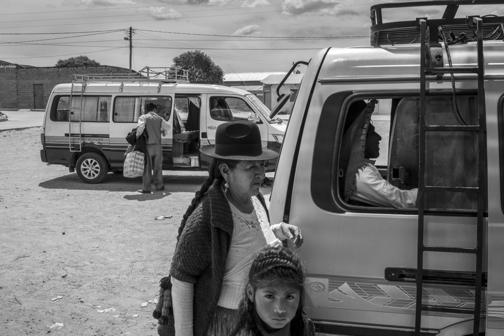
In Mexico, Morales seemed insulated from the reality of his situation and oddly unaware of the impression he made. Many MAS loyalists I spoke to complained that he had been increasingly imperious as he extended his time in office, but that aides protected him from consequences. Marcela Araúz, a former communications director for Bolivia’s Congress, said that he had been surrounded by llunkus, or “ass-lickers,” who had brought about the crisis by abetting his “despotic tendencies.” Waldo Albarracín listed offensive incidents. In 2010, Morales bought a new Presidential jet, for thirty-eight million dollars. “He wanted to watch the World Cup, so he took his plane and his entourage with him,” Albarracín said. “Idi Amin-style tastes!” In 2011, Morales tried to push a highway through an indigenous reserve in the tropical lowland, inspiring protests so intense that the government had been forced to back down. Last summer, forest fires blazed through eastern Bolivia, ravaging the wilderness known as La Chiquitania. For weeks, Morales sat idle, refusing to accept international aid and blocking Argentine firefighters from entering the country. By the time the fires subsided, more than four million acres of forest had been scorched.
In La Paz, I visited Morales’s former office, which suggested a serene remove from the details of governance. His desk was entirely bare. In contrast, the adjoining office of his Vice-President, Alvaro García Linera, looked as if he never went home. The desk overflowed with reports and papers, and a suit hung from a hook on a filing cabinet. Crayon drawings by a young child were taped to the window.
I met García Linera in a park next to Avenida Reforma, Mexico City’s grand central boulevard. A slim, silver-haired man of fifty-seven, he was dressed in a neatly cut business suit. His looks are deceptive: a Marxist theoretician, he once spent five years in prison for his involvement in the revolutionary Túpac Katari Guerrilla Army. Conservative Bolivians despised García Linera, a university-educated white man, as a traitor to their class. MAS partisans blamed him for abetting Morales’s excesses; militants suspected him of colonialist sympathies. Everyone suspected that he was the real brains behind Morales.
García Linera hoped that the “de-facto regime” of Áñez would soon be gone, so that MAS could resume the projects that he and Morales had left unfinished. But he would not risk returning home anytime soon—not openly, anyway. When I asked whether it had been a mistake for him and Morales to seek a fourth term, he held my gaze for a long moment, and said, “I’m sure we made lots of mistakes, but I think that now is not the right time to discuss them in public.”
One evening, I walked across the plaza outside Palacio Quemado to Bolivia’s legislature, where Morales’s Clock of the South was still ticking away in reverse. Inside, I met with Eva Copa, the president of the Senate. Copa, an ethnic Aymara from El Alto, is thirty-three, with black hair and glasses. A backbench politician with only five years’ experience, she was asked by her party to fill in after all the senior officials departed. She had assumed a role resembling that of her American equivalent Nancy Pelosi, having to work with a government to which she was deeply opposed.
After Morales’s fall, MAS had retained the majority in the legislature, but, in early December, it began negotiating with the Áñez administration. Copa discreetly made it clear to me that her decision to work with “la señora Áñez” had been unpopular with the more militant members. But, Copa explained, she had seen no other way to end the crisis, and ordinary Bolivians were suffering; she herself had young children, and, at the height of the violence, the MAS blockade had kept her from going home to see them for two weeks. She did not directly criticize Morales, nor did she mention him much. Later, a former senior MAS official confided, “The quest for a fourth term was a mistake, and this is the consequence. We all know it. They are going to make us pay for it in the next elections, too. We’re just going to have to learn from our mistakes, and hope to survive.”
Jerjes Justiniano, who served as Áñez’s chief of staff during the transition period, said that he had noted a rift among Morales’s followers, “between the hard-liners who opposed any negotiations and those who were open to dialogue.” He had been in constant negotiation with the pro-dialogue faction, which had quickly agreed to help stop the violence; later, a majority of MAS legislators voted to ratify Morales’s resignation. Justiniano gloated, “They’re negotiating because they could see there was no chance of success in persisting with the violent confrontation, and that is also a tacit acknowledgment of the legitimacy of this government.”
(below) El Alto, effectively the capital of indigenous Bolivia, prospered under Morales, while maintaining the culture of the high plains.Photograph by Moises Saman / Magnum for The New Yorker
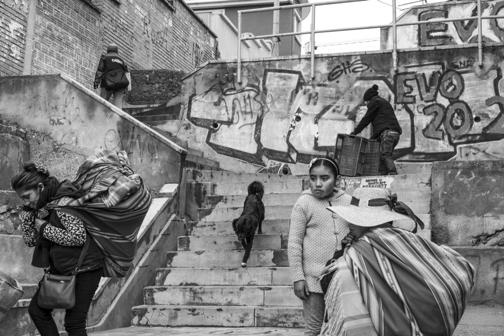
Before working for Áñez, Justiniano was a prominent lawyer from the opposition stronghold of Santa Cruz. (Controversially, he led the defense for two members of the Wolfpack, a group of five young men who were accused of a gang rape.) I asked him about the accusations that, even if Morales had committed electoral fraud, the new administration had responded with what amounted to a military putsch. Justiniano laughed and said that the complaints reminded him of a passage from “Don Quixote”—apocryphal, it turns out—in which the knight-errant tells his sidekick, “Let the dogs bark, Sancho. It’s a sign that we’re advancing.”
In La Paz, politicians seemed ready for a grudging compromise, but in the indigenous country of the altiplano the mood remained defiant. Evo’s home village of Orinoca lies six hours by car from La Paz. Orinoca comprises only a few hundred people, but on its outskirts looms a massive concrete-and-glass building of sharply angled geometry: the Museum of the Cultural and Democratic Revolution, which Morales built, at a cost of seven million dollars, to present the country’s history from the indigenous point of view. On a dirt lane outside the museum, I met an ancient woman, who was tending a herd of llamas. She wore an Evo campaign T-shirt that read “The people say yes.” She had lived her whole life in Orinoca, she said, but she had been to La Paz a few times, to show support for Morales in rallies and demonstrations. When I asked how she felt about the political change that Áñez had brought to the country, she replied with a baseless but widespread insult: “That whore. I hear she used to sell her body for money.” She hoped Evo would be back in power soon. He had been good for the people of the altiplano.
Morales’s opponents accused him, not unfairly, of favoring the altiplano, but his efforts also helped redress a historic injustice. After the brutal Spanish conquest, indigenous Bolivians were subjected to a feudal labor system that remained in place until the nineteen-fifties, and were effectively denied the vote. Even after laws changed, racial attitudes remained deeply entrenched, and indigenous citizens lived mostly in poverty, without access to land titles, bank loans, university education, or government jobs.
Morales made such reforms his priority. But, as indigenous Bolivians prospered, the white population felt excluded. Albarracín suggested that Morales had overseen a clash of basic ideals: “Western values versus the indigenous cosmovision.”
El Alto is effectively the capital of indigenous Bolivia. A bare-bones sprawl on the brown plain that begins at the La Paz crater’s edge and extends to the horizon, the city is predominantly Aymara, and largely populated by migrants from poor rural areas. It reflects Bolivia’s indigenous highland culture, with many of the women dressed in bowler hats and the bright-colored, bunched-out skirts called polleras; there are open-air food markets, hard-drinking bars, and a rough red-light district.
Thirty-five years ago, El Alto was little more than a huddle of adobe dwellings and market stalls. After the boom of the Evo years, it has a million inhabitants, and an exuberant local architecture, with façades covered in colorful glass and rooflines that jut out at eccentric angles. One new apartment building that I walked past had a towering replica of the Statue of Liberty incorporated into its upper floors.
Alexis Argüello, a thirty-three-year-old bookseller, told me that for most of his life he was ashamed to tell people that he was from El Alto. Gradually, the shame had been replaced by something like pride. A few years ago, he launched a small publishing imprint to showcase local writers. “For all of Evo’s despotism and his government’s faults, he helped create a new middle class from among people with more copper-colored skin,” Argüello said. He had all but forgotten the indignities of life before, “such as the need to explain myself to police.” Under the new administration, though, policemen had again begun antagonizing young men from El Alto.
For Áñez, antagonizing the indigenous is a significant risk. Although increasing numbers of Bolivians identify as mestizo, the population remains heavily indigenous, and the community’s partisans are not easily intimidated. On El Alto’s streets, effigies dangle from nooses attached to street lights, with placards that warn potential criminals of “popular justice.” One sign said “Rats Who Are Caught Will Be Hanged and Burned.”
Bolivia has a long history of organized protest, notably by miners and by the cocaleros whom Morales once represented, who assert their influence with marches, blockades, and street battles with police. Demonstrating miners often throw dynamite sticks, and deaths and injuries are not uncommon. In 2016, Morales’s vice-minister of the interior went to a roadblock to negotiate with striking miners; they kidnapped him and tortured him to death.
In recent months, some of these same uncompromising partisans have come to Morales’s defense. When he accused Áñez of fomenting a coup, hundreds of Aymara militants wearing red ponchos swarmed down the mountainside into La Paz, chanting, “Civil war now!” After the massacre at the Senkata gas facility, pro-Evo mobs destroyed seven of El Alto’s eight police stations.
(below)In Santa Cruz, a center of opposition to Morales, residents celebrated his resignation. One rival hailed “the end of the tyranny.”Photograph by Moises Saman / Magnum for The New Yorker
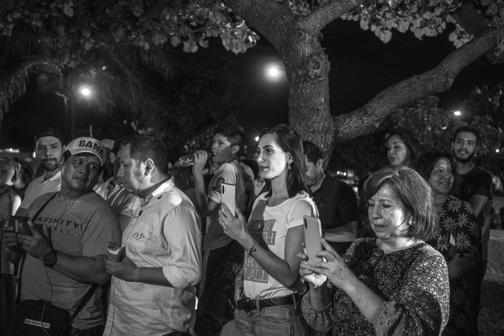
The city’s policemen regrouped in the surviving station, in a middle-class neighborhood on the southern edge of town, where a sign over the gate read “Against Evil, for the Good of All.” During my visit, hundreds of policemen from the burned-out districts were there, readying for patrols or taking shifts sleeping on the floor of an auditorium. A new police commander, Colonel Juan Carlos Alarcón, had been brought from the mining town of Oruro to impose order on the convulsed city. “It is with some pain that I take over here,” he told me. “The job now is to reconcile this fracture that has opened up between the society and the police.” I asked him about the neighborhood around Senkata, which by all accounts still seethed with anger toward the police force. Alarcón said he was organizing a potluck lunch, and he hoped that Senkata people would attend. He was also intending to hold a Catholic Mass, he said, “for those of us who believe in God.”
The town seemed unreceptive. One morning, a fund-raiser was held on El Alto’s scrappy outskirts for the families of the victims of the massacre. In a small plaza, just past the Senkata facility, a stage had been set up, with a backdrop that read “The coup is against the people.” An Andean band played charango and flute, and a group of university students from La Paz danced. The smell of burning palo santo filled the air, and venders sold “solidarity food”—empanadas and hot dogs—with the proceeds going to the victims’ families. A bulletin board next to the stage showed photographs of the dead, and placards read “This democracy censors, persecutes, and kills.”
A pale, bearded man stood onstage and explained that “oil companies backed by Yankee imperialism” had been behind the events in Senkata. He spoke about unrest in Mexico, strife in Palestine, and the protesters in Hong Kong, concluding, “It’s all the same struggle.” He was followed by a rapper, who delivered furiously charged lyrics that described the Palestinians and the people of El Alto as allies in the “battles of the world.” In the end, he said, “the true resistance is right here.”
When I saw Morales in Mexico, he told me that he had been up since three-thirty that morning, working the phones, strategizing with his supporters. From exile, he carefully monitored the developments back home, and adjusted his message as necessary to keep himself relevant. When MAS agreed to start negotiating with the Áñez government, he shook off the slight and announced that he would no longer seek to be President. After his deputies voted to accept his resignation, Morales took on a new role, as the Party’s campaign manager. If he could no longer be king, he would be the kingmaker.
In mid-December, Morales called in to a gathering in Cochabamba, where several thousand MAS loyalists had assembled to discuss the Party’s future. Cochabamba, Bolivia’s third-largest city, sits in a fertile Andean valley southeast of La Paz—the gateway to the Chapare, the coca-growing region that is Morales’s political base.
The assembly was held at a stadium called La Coronilla. On the sidewalk, people hawked DVDs: “Learn the truth about the coup financed by the United States!” Inside, several thousand people filled the bleachers, waving wiphala flags and buying snacks from strolling venders. A folk musician sang anti-imperialist lyrics to warm up the crowd. Miners wearing orange plastic helmets strode around purposefully.
As horns called the crowd to attention, an announcer welcomed MAS delegations from around the country, to cheers in Spanish, Aymara, and Quechua. The national anthem played, and people stood, one hand over their heart and the other clenched in a fist. After a moment’s silence for fallen comrades, the leader of the Cochabamba MAS contingent spoke, ending with a shout of “Down with traitors!,” which the crowd echoed rowdily. When the announcer declared that Morales “will return soon,” there were chants of “Evo, Evo, Evo!” and “Evo, you are not alone!”
I was sitting with a woman who had worked in Morales’s administration. She had quit out of frustration with the privileged circle around Evo—the llunkus, as she called them, “who surrounded and isolated him from the people.” There was a rumor that Morales might leave Mexico for Argentina, and, if he did, she said, “I hope he goes alone so he can be by himself for a while, and think. He needs to.”
(below) Although some of Morales’s supporters grew frustrated with his attempts to hold on to power, most allies have largely maintained solidarity in public.Photograph by Moises Saman / Magnum for The New Yorker
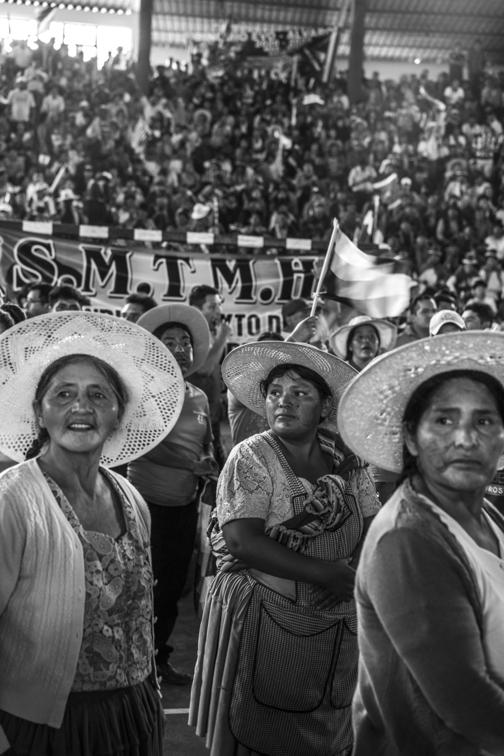 Still, the former aide joined in as the crowd chanted pro-Evo slogans. “The idea behind this assembly is unity, to leave divisions behind,” she said. The crowd was unruly, and the atmosphere was tense; it was the first time since Morales’s resignation that MAS had gathered in large numbers, and police helicopters buzzed in the air outside. She showed me Twitter messages sent by right-wingers; one urged the government to take advantage of the assembly to “capture the MAS criminals.” In the bleachers, people took up defiant chants: “Long live our wiphala, long live our coca leaf!” Someone handed out a bitter message printed on a flyer:
Still, the former aide joined in as the crowd chanted pro-Evo slogans. “The idea behind this assembly is unity, to leave divisions behind,” she said. The crowd was unruly, and the atmosphere was tense; it was the first time since Morales’s resignation that MAS had gathered in large numbers, and police helicopters buzzed in the air outside. She showed me Twitter messages sent by right-wingers; one urged the government to take advantage of the assembly to “capture the MAS criminals.” In the bleachers, people took up defiant chants: “Long live our wiphala, long live our coca leaf!” Someone handed out a bitter message printed on a flyer:
Áñez, little dyed woman,
Self-proclaimed dictator,
you authorized the killing of
Bolivians, you murderer!
Sellout to Yankee imperialism,
Accursed traitor,
The BOLIVIANS say
you will not pass,
Nor will God pardon your hypocrisy.
A speaker announced that “President Evo” was going to speak, and a hush fell. A moment later, Morales’s voice filled the stadium. He saluted his “compañeros y compañeras,” denounced the “fascist, racist coup,” and promised that he would “soon be back in Bolivia.” The crowd clapped and cheered. Evo stressed the need for unity and for the assembly to agree on candidates for the upcoming elections, which he was sure the Party would win.
After Morales signed off, another delegate came onstage to denounce the “cowards and sellouts” who had abandoned their positions during the crisis, taking refuge in embassies or fleeing the country. The former aide explained the vindictive tone: “Many of those who went into the embassies are seen as cowards because they were not actually being persecuted.”
From the crowd, I spotted one of the officials who had resigned: Adriana Salvatierra, the former Senate leader, whose departure had allowed Áñez to take power. Salvatierra, thirty years old, with long hair, wore jeans and a black T-shirt that depicted a rising sun. I asked her if it had been a mistake for Evo and the MAS leadership to resign, given everything that had happened since. “We made some tactical and also strategic mistakes,” she allowed. What about herself? She could be Bolivia’s President right now. Did she have any regrets? Salvatierra shook her head. Even if she had tried to assume the Presidency, Morales’s opponents would not have let her. “A coup was under way, and had been planned long beforehand,” she insisted. “History is a constant dialectic, not permanent, and there are advances and also reverses.”
Morales’s speech had reinforced his bid to remain the de-facto leader of Bolivia. But, from exile, he seemed far more able to divide the country than to lead it. I asked Salvatierra what she thought about his promise to come back, despite the government’s threat to arrest him. She said, “The President’s leadership will not be diminished if he is imprisoned.” She reminded me that Morales had always presented himself as a revolutionary, and added, “If he is arrested, we’ll mobilize.”
Two blocks downhill from the Great House of the People, an unusual sculpture stands in the median of a busy street: a memorial to wartime defeat. It features a bronze tableau of a shirtless soldier, dying with his gun in his hand. A message spray-painted on the marble base dedicates the monument “to those fallen for democracy.” Next to it, an embankment planted in multicolored flowers spells out “Honor and glory.”
One evening in La Paz, the former senior MAS official suggested that his country’s impasse was rooted in its history of defeat. Except for a few internal uprisings—a U.S.-assisted campaign that crushed Che Guevara’s guerrillas, in 1967, and a couple of indigenous revolts quelled by massacres, in the nineteenth century—Bolivia had lost every war it engaged in. In the War of the Pacific, in the eighteen-seventies, it lost its coastline to its neighbor Chile. In the Chaco War, in the nineteen-thirties, it surrendered another huge swath of territory to Paraguay. “Our defeats are what made us different,” the official said. “It doesn’t matter to us if we lose. The thing we take pride from is our bravery in fighting back, in resisting.”
In recent weeks, it has become clear that neither side intends to give up the fight. Morales, who has moved to Argentina, has called for the founding of civilian militias in Bolivia. (After a media uproar, he retracted the statement, saying that he had always “defended life and peace.”) Áñez expelled the Spanish and Mexican Ambassadors, whom she suspected of conspiring to sneak Morales loyalists out of the country. Mauricio Claver-Carone, a Cuban-American who is the National Security Council’s senior director for Western Hemisphere affairs, showed up in La Paz to discuss new aid agreements with Áñez, while chiding Argentina’s government for allowing Morales to “foment violence.” In Washington, Erick Foronda and Arturo Murillo posed for photographs with Marco Rubio.
Elections are scheduled for May, and Morales announced his favored candidate: his former economy minister, Luis Arce. Áñez, who had invited USAID back, to give “technical aid” with the elections, announced that she, too, would run for President. There was backlash from the political class: her minister of communications quit, saying that Áñez was following Evo’s playbook, and the former candidate Carlos Mesa protested. But the military, under a new commander appointed by Áñez, expressed no concern as her “interim government” tried to make itself permanent.
Morales’s alleged electoral fraud, and his party’s acceptance of new elections without him, makes it difficult to call his ouster a coup. Añez’s behavior makes it hard not to. In addition to the violence committed by security forces, her government announced early this year that it would investigate nearly six hundred former members of Morales’s administration. According to the United Nations, at least a hundred and sixty people, including senior officials, have been prosecuted or detained, on accusations that range from corruption and terrorism to “making illegal appointments.” In January, Áñez, urging unity in the elections, warned the country not to allow “the savages to return to power.”
Marcela Araúz, the former MAS communications director, complained of the “blindness of Bolivia’s middle class,” who supported the new status quo “but who don’t seem to get that Evo’s fraud doesn’t mean there wasn’t a coup.” There was real persecution happening in Bolivia, she said, and she was outraged at the media silence about it. Like others I spoke to, Araúz felt certain that a right-wing regime would do whatever was necessary to triumph in the elections: “Now that they have the control, they are not going to let it go.” ♦